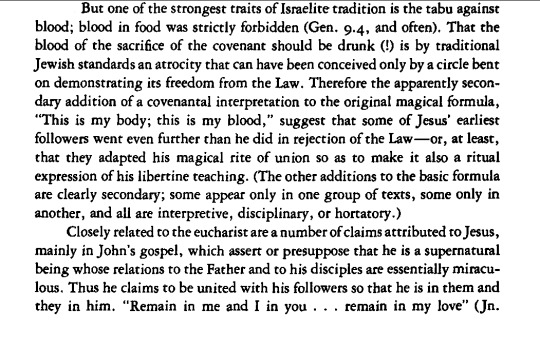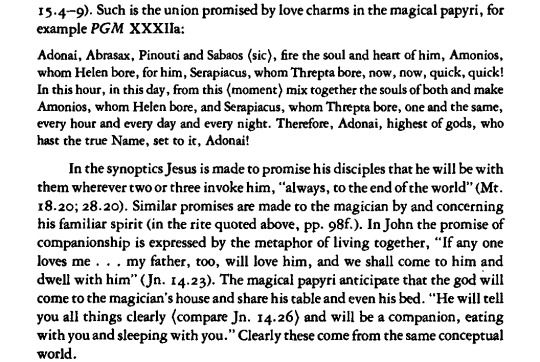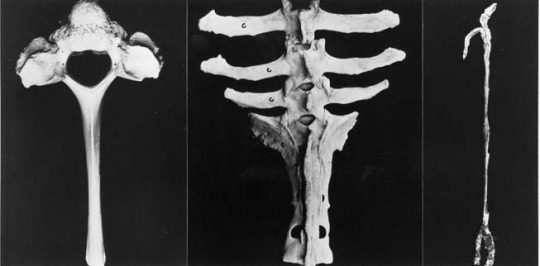Text
I've read enough bara to know it's mating press
A man calls himself God.
I tell him "Nice to meet you, I'm the Devil!"
What happens next?
7 notes
·
View notes
Text
Even when I don't feel a special sympathy towards Christianity, I've to admit Jesus seems one of the few magicians that effectively —probably more effectively than anyone before and after him—achieved the goal of reaching the status of divinity/being one with the Gods— he did not only turned himself into a living God, but was —and still is— recognized as one by all for it (ok, yeah, both the curation of textual sources for New Testament to avoid the magical stuff and St. Paul helped a lot, but you know)
#esoteric christianity#jesus#jesus the magician#also literally bainchôôôch#one of the triple powered gods#descended to jesus
25 notes
·
View notes
Text


Morton Smith, Jesus the Magician.
#graeco egyptian magic#esoteric christianity#jesus the magician#jesus#greek magical papyri#pgm#morton smith#papyri graecae magicae#eucharist
8 notes
·
View notes
Text

Morton Smith, Jesus the Magician
#graeco egyptian magic#demotic magical papyri#papyri demoticae magicae#pdm#jesus the magician#morton smith#esoteric christianity#osiris#jesus#magiké techné#eucharist
5 notes
·
View notes
Text
White nationalists have a strange habit where they think they're saying something subversive or pointing some kind of absurd contradictions when they mockingly say stuff like "diversity is divinity", as if to dismiss any affirmation of social diversity as a cult while themselves often being religious in some way (usually Christian). The irony is that, while they mean to mock and dismiss the idea, the notion that diversity being divine in any way is actually a pretty basic part of polytheistic theology, and probably has been for thousands of years, even within the tradition of Platonic philosophy with its stress on ontological unity.
9 notes
·
View notes
Text
Though I personally agree with @khensaptah concerning community aspects, would also add that there are problems inherent to the revival of long ago interrupted polytheist traditions in societies heavily influenced by Christianity (or other monotheist faiths) societies since millennia (I'd say secular, but it would be the same as saying "Christian yet blunt") that leads easily to dissatisfaction and conflict, starting with the fact our societies are radically different, then you can find; mythification (and mystification) of the past, continuist bias, presentism, cookie-cutter methods, interpreting polytheist theologies through products of Christian thought like mythic literallism, having access to these cultures' religious/literary/textual corpus only via secondary or even tertiary sources, limited understanding of how these polytheisms worked (which normally results in cultural essentialisms, reactionary stances, tremendous antipathy and unfriendliness toward clearly proved phenomena among polytheisms in the past like sincretism, etc), the lack of a theological and/orcommunal religious project aside "worshipping the Gods", mostly caused, among other things, by the fact most of our communities are confined into online spaces where a great percentage of their members try polytheism as reaction to a monotheist education. I thing all of these questions ends provoking not only expectatives that finally doesn't meet, but a rigid, frustrating and sometimes even almost-empty religious project.
The amount of people leaving kemeticism to converting to another creed (or no creed at all) should catch me by surprise, but actually no.
23 notes
·
View notes
Text
The amount of people leaving kemeticism to converting to another creed (or no creed at all) should catch me by surprise, but actually no.
#kemeticism#polytheism#ramblings#the so called kemetic revival as conceived in online spaces like tumblr is a thing#not to speak about the kemetic orthodoxy scam
23 notes
·
View notes
Text
Abstraction is a dark magical art. We're distilling materiality into ideality, reversing the work of Gods.
7 notes
·
View notes
Text
About the notion of power and the personification of the divine in the Egyptian religion, Morenz rightly points out that, “we proceed from ‘power’ as primary cause, which can elevate to the rank of deity man and animal, even plant and object, so that neither animal nor plant, still less inorganic matter, ever ceases to be God in potentia.”
The Concepts of the Divine in the Greek Magical Papyri by Eleni Pachoumi
I kind of just thought it was interesting
23 notes
·
View notes
Text
Living sword in hand, even inwardly and in silence, remains the greatest way.
10 notes
·
View notes
Text

Sekhmet Rising
Finally finished this older collab with the very talented Anisis! I made the sketch years ago, which she then turned into incredible lineart.
As I recently went on a trip to Egypt it inspired me to finish this artwork featuring one of my favorite goddesses. I think many of us were obsessed with Egyptology as a kid and to finally see all the ancient temples, statues and art in real life really took my breath away and I have no proper words to describe this experience...the heat and cramps were worth it and so much more (photos will come later when I find the energy to do so).
Prints: https://artofmaquenda.etsy.com/listing/1589664059/sekhmet-rising-lustre-print-kemet
1K notes
·
View notes
Text
“Everything is overflowing with Gods.”
— Proclus, 1st century CE
2K notes
·
View notes
Text
Instead of making posts about what people halfway across the world should do on a dying website, I'm going to link to organizations that you can donate to that can actually help.
Medical Aid for Palestinians (MAP) works for the health and dignity of Palestinians living under occupation and as refugees. They provide immediate medical aid to those in great need, while also developing local capacity and skills to ensure the long-term development of the Palestinian healthcare system.
Addameer Prisoner Support and Human Rights Association is a Palestinian non-governmental civil institution that works to support Palestinian political prisoners held in Israeli and Palestinian prisons.
Samidoun is an international network of organizers and activists working to build solidarity with Palestinian prisoners in their struggle for freedom.
Refuser Solidarity Network provides crucial support to Israel's military refusers in the toughest of political circumstances. They provide funds for for demonstrations outside prison, for legal fees, for media campaigns that tell conscientious objector’s stories to the general public, for education programs for Israeli and American audiences about their important resistance to the occupation.
Feel free to reblog with links to other groups and other places people can donate to.
26K notes
·
View notes
Text

Andrew Gordon & Calvin Schwab, The Quick and the Dead: Biomedical Theory in Ancient Egypt
#polytheism#sutekh#sēt#egyptian polytheism#dinka of sudan#big red#sutesh#setesh#netjer#netjeru#the phallic stuff is an analogy of how set's creative powers fight entropy by endless generation
19 notes
·
View notes
Text
These and other Dinka associations of Ring (and Garang) with shining, the sun, fire and the color red (including red steers) remind us too of Morenz’s associations of red with the Egyptians’ living bull gods Buchis and Mnevis, as well, of course, as with Seth. Vos also describes the red kfa cloth, one of two which covered the Apis bull in burial, and connects it with Seth. As the color of Seth, red could symbolize mischief, but it could also symbolize life, have protective powers and denote joy and victory The red cloth, supplied by the Per-Ankh, the House of Life, was occasionally associated with the sun god Re and the Opening-of-the-Mouth ceremony. For the Greeks and Romans as well, red could symbolize death and the underworld on the one hand, but also life on the other.
Andrew Gordon & Calvin Schwab, The Quick and the Dead: Biomedical Theory in Ancient Egypt
6 notes
·
View notes
Text
Recalling such multiple associations of Seth with bulls and heavenly-weather phenomena like thunder and lightning, it is interesting that the Nilotic Dinkas’ god manifestation Macardit (literally great black bull), is also equated with black thunderheads. The thunder is said by some Dinka to be his ecstatic bellow, the lightning his ejaculate and the rain his semen fertilizing the earth. Similar ideas are recorded from antiquity. Thus, Dionysus, too, was associated with lightning and the origins of cattle rites related to his worship were ascribed by ancient Greeks to Egypt.
Andrew Gordon & Calvin Schwab, The Quick and the Dead: Biomedical Theory in Ancient Egypt
#polytheism#sutekh#sēt#egyptian polytheism#dyonisus#dinka of sudan#marcadit#relevant to my personal theology#min
10 notes
·
View notes
Text
Currently reading Andrew Gordon and Calvin Schwab's "The Quick and the Dead: Biomedical Theory in Ancient Egypt" and though I was familiarized with the fact that Djed Pillar and Ankh could have their iconographical origins in bulls' last three lumbar and sacrum vertebrae in dorsal perspective and thoracic vertebra in cephalic perspective respectively, I wasn't ready for the Was sceptre being (or, at least, having it's predecesor in) a dried bull penis, which definitely makes sense due the connotations of power and dominion of both the Was sceptre and wild bulls.
Like, fuck


I think, by the way, this also helps understand and highlight better not only certain iconographical aspects of Set (and from other Gods as well, but concerning different aspects, I'd say) in relation to bulls and their anatomy, but some theological ones as well.
#ancient egypt#sutekh#sēt#polytheism#biomedicine#ankh#was#djed#was sceptre#djed pillar#this also is relevant for ptah#ptah
34 notes
·
View notes